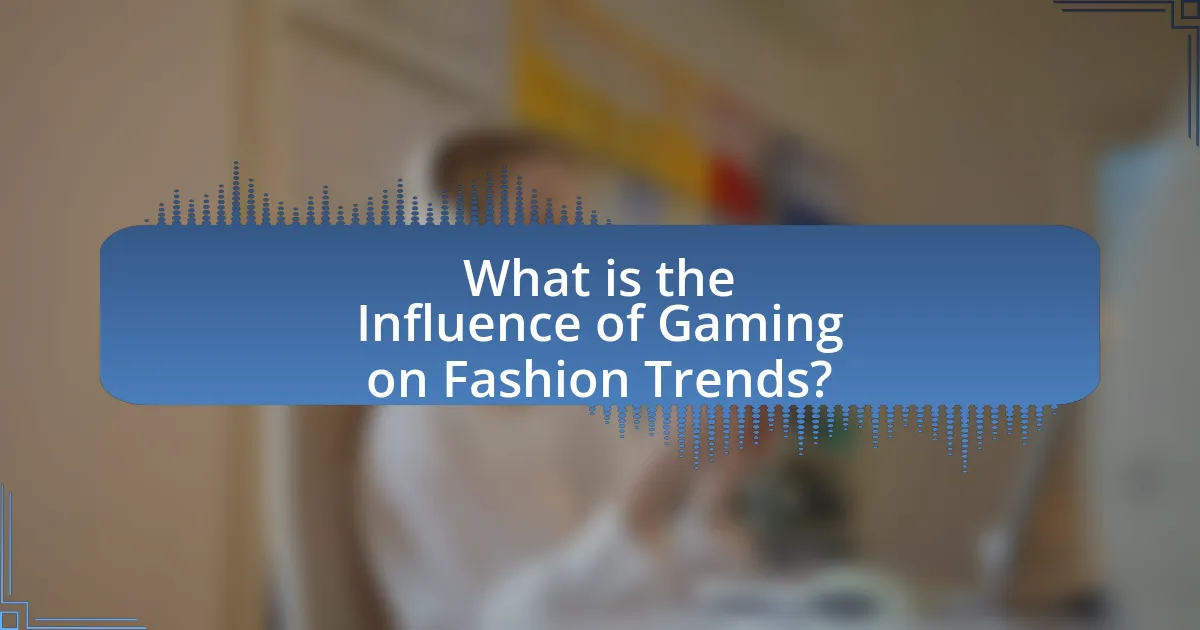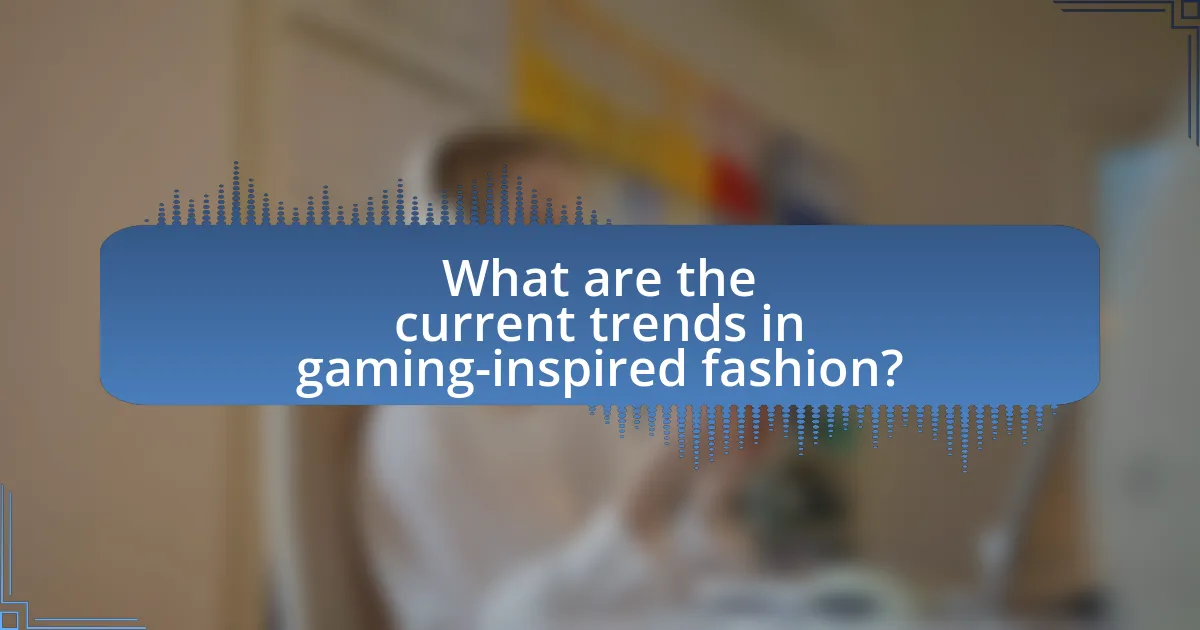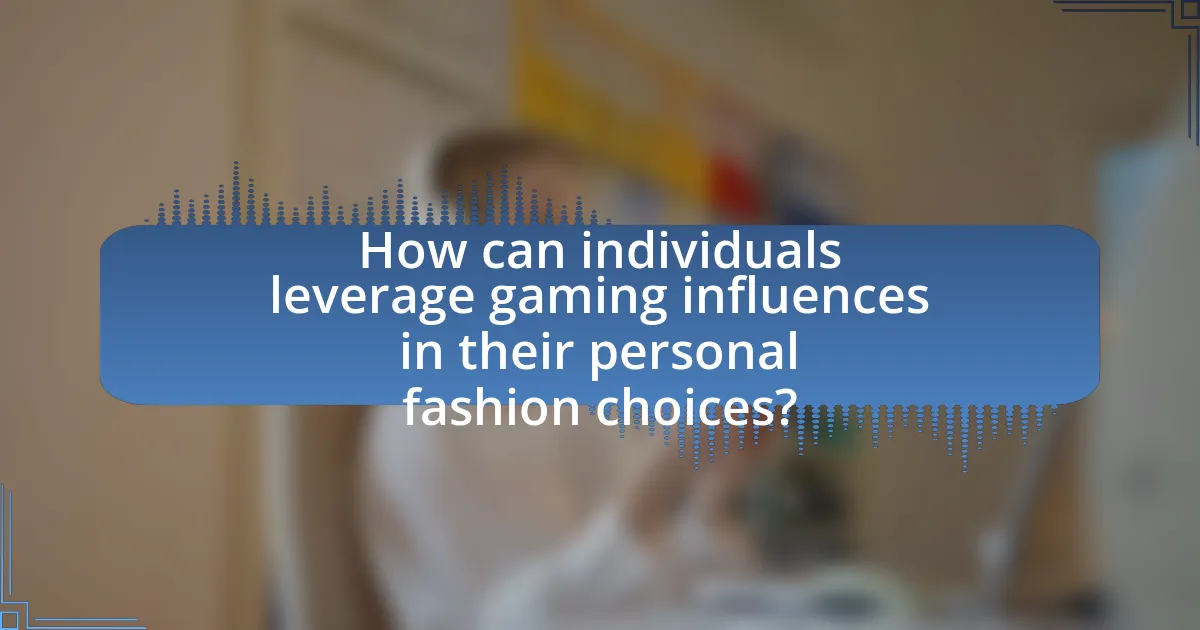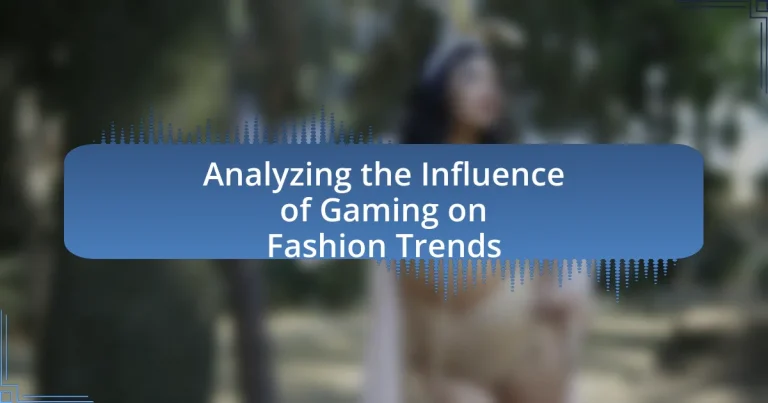The article analyzes the influence of gaming on fashion trends, highlighting how video games introduce unique aesthetics that resonate with players and inspire real-world fashion. It discusses historical impacts, notable collaborations between gaming franchises and fashion brands, and the role of gaming communities in shaping consumer preferences. Key factors driving this influence include the integration of virtual avatars, the rise of esports, and technological advancements such as augmented and virtual reality. The article also explores emerging styles, the balance between authenticity and commercialism, and future implications for the fashion industry as it continues to intersect with gaming culture.

What is the Influence of Gaming on Fashion Trends?
Gaming significantly influences fashion trends by introducing unique aesthetics and styles that resonate with players. Popular games often feature distinct character designs and outfits that inspire real-world fashion, leading to collaborations between game developers and fashion brands. For instance, the collaboration between Fortnite and various fashion labels has resulted in clothing lines that reflect the game’s vibrant style, demonstrating how gaming can shape consumer preferences. Additionally, the rise of virtual fashion in gaming environments, such as skins and outfits, has encouraged players to adopt similar styles in their everyday lives, further bridging the gap between gaming and fashion.
How has gaming historically impacted fashion trends?
Gaming has historically impacted fashion trends by introducing iconic styles and aesthetics that resonate with players and influence mainstream fashion. For instance, the popularity of characters like Lara Croft from the “Tomb Raider” series in the late 1990s led to a surge in demand for tactical and adventure-inspired clothing, which was reflected in streetwear and casual fashion. Additionally, the rise of esports and gaming culture in the 2010s brought about a blend of athletic wear and casual styles, as seen in collaborations between gaming brands and fashion designers, such as the partnership between Adidas and the “Call of Duty” franchise. This intersection of gaming and fashion illustrates how visual elements from video games can shape consumer preferences and inspire designers, ultimately leading to trends that permeate various aspects of everyday attire.
What are some notable examples of fashion influenced by gaming?
Notable examples of fashion influenced by gaming include the collaboration between luxury brands and video game franchises, such as Louis Vuitton’s partnership with League of Legends, which featured exclusive clothing and accessories. Another example is the rise of streetwear brands like A Bathing Ape, which has incorporated gaming aesthetics from titles like Street Fighter into their designs. Additionally, the popularity of cosplay has led to mainstream fashion trends, with characters from games like Final Fantasy inspiring real-world clothing lines. These instances demonstrate the significant impact gaming has on contemporary fashion, as evidenced by the increasing presence of gaming motifs in high-end collections and streetwear.
How do gaming aesthetics translate into real-world fashion?
Gaming aesthetics translate into real-world fashion through the incorporation of visual elements, themes, and character designs from video games into clothing and accessories. This phenomenon is evident in collaborations between fashion brands and gaming companies, such as the partnership between Louis Vuitton and League of Legends, which showcased gaming-inspired designs on luxury apparel. Additionally, the rise of streetwear has embraced gaming culture, with graphics, logos, and color palettes reminiscent of popular games becoming mainstream in everyday fashion. The influence is further supported by the growing presence of gaming in popular culture, as seen in events like E3 and the rise of esports, which have led to increased visibility and acceptance of gaming aesthetics in fashion.
Why is the intersection of gaming and fashion significant?
The intersection of gaming and fashion is significant because it reflects the evolving cultural landscape where digital experiences influence real-world aesthetics and consumer behavior. This convergence allows fashion brands to tap into the gaming community, which is projected to reach over 3 billion players globally by 2025, creating new marketing opportunities and revenue streams. Collaborations between game developers and fashion designers, such as the partnership between Fortnite and luxury brands like Balenciaga, demonstrate how virtual environments can shape fashion trends and consumer preferences, ultimately bridging the gap between digital and physical identities.
What cultural shifts have occurred due to gaming’s influence on fashion?
Gaming has significantly influenced fashion by popularizing streetwear and casual styles, leading to a cultural shift towards more relaxed and expressive clothing choices. This shift is evident in collaborations between gaming brands and fashion designers, such as the partnership between Fortnite and luxury brands like Balenciaga, which merges gaming aesthetics with high fashion. Additionally, the rise of gaming culture has normalized the use of graphic tees, hoodies, and sneakers as everyday attire, reflecting the values of comfort and individuality. The impact is further supported by the increasing visibility of gaming influencers and streamers who showcase these styles, thereby shaping mainstream fashion trends.
How do demographics play a role in this influence?
Demographics significantly influence the intersection of gaming and fashion trends by determining the preferences and behaviors of different age groups, genders, and cultural backgrounds. For instance, younger demographics, particularly those aged 18-34, are more likely to engage with gaming and subsequently adopt fashion trends inspired by gaming characters and aesthetics, as evidenced by a report from the Entertainment Software Association indicating that 70% of gamers fall within this age range. Additionally, gender demographics play a crucial role; female gamers are increasingly influencing fashion trends, with brands like Fortnite collaborating with fashion designers to create in-game outfits that resonate with this audience. Cultural backgrounds also shape fashion choices, as diverse gaming communities bring unique styles and influences, further diversifying the fashion landscape.
What are the key factors driving the influence of gaming on fashion?
The key factors driving the influence of gaming on fashion include the integration of virtual avatars, collaborations between fashion brands and game developers, and the rise of gaming culture in mainstream media. Virtual avatars allow players to express their personal style, leading to increased interest in fashion items that mirror in-game aesthetics. Collaborations, such as those between Fortnite and luxury brands like Balenciaga, create buzz and visibility for fashion within gaming contexts. Additionally, the growing acceptance of gaming as a cultural phenomenon, evidenced by events like the Met Gala featuring gaming themes, further solidifies the connection between gaming and fashion.
How do character designs in games inspire fashion trends?
Character designs in games inspire fashion trends by introducing unique aesthetics and styles that resonate with players and consumers. These designs often feature bold colors, innovative silhouettes, and thematic elements that reflect current cultural movements. For instance, the popularity of characters from games like “Final Fantasy” and “Overwatch” has led to the emergence of streetwear lines that incorporate similar visual motifs, such as oversized silhouettes and graphic prints. Additionally, collaborations between fashion brands and gaming franchises, such as the partnership between Louis Vuitton and “League of Legends,” further validate the influence of game character designs on mainstream fashion. This intersection of gaming and fashion is evidenced by the increasing presence of gaming-inspired apparel at major fashion events and the rise of cosplay as a legitimate fashion statement.
What role do gaming communities play in shaping fashion choices?
Gaming communities significantly influence fashion choices by promoting specific styles and trends through shared experiences and cultural references. These communities often engage in discussions about character aesthetics, leading to real-world fashion adaptations inspired by in-game outfits and themes. For instance, the popularity of games like “Fortnite” and “League of Legends” has resulted in collaborations with fashion brands, showcasing how virtual styles can translate into physical apparel. Additionally, social media platforms amplify these influences, as gamers showcase their fashion choices, further driving trends within and beyond the gaming community.
How do brands collaborate with gaming to influence fashion trends?
Brands collaborate with gaming to influence fashion trends by integrating their products into popular video games and leveraging in-game advertising. This strategy allows brands to reach a vast audience of gamers, who often engage with the virtual environments where these products are showcased. For instance, collaborations like Nike’s partnership with Fortnite introduced exclusive virtual sneakers, which not only generated buzz but also translated into real-world sales, as seen with the 2020 launch of the Air Max 270 React, which was inspired by the game. Additionally, brands often create limited-edition merchandise based on game aesthetics, further driving consumer interest and trend adoption. This approach is validated by the increasing number of fashion brands entering the gaming space, with a report from the NPD Group indicating that 70% of gamers are interested in fashion collaborations within games.
What are successful examples of fashion brands partnering with gaming companies?
Successful examples of fashion brands partnering with gaming companies include the collaboration between Gucci and Roblox, which launched a virtual collection in 2021, allowing players to purchase digital items. Another notable partnership is between Balenciaga and Fortnite, where the brand introduced a range of in-game outfits and accessories in 2021, enhancing brand visibility among gamers. Additionally, Louis Vuitton collaborated with League of Legends in 2019, creating exclusive in-game skins and a capsule collection, which significantly boosted its engagement with the gaming community. These partnerships demonstrate how fashion brands leverage gaming platforms to reach new audiences and create immersive experiences.
How do these collaborations affect consumer behavior?
Collaborations between gaming brands and fashion companies significantly influence consumer behavior by creating a unique blend of cultural relevance and aspirational marketing. These partnerships often lead to limited-edition products that generate urgency and exclusivity, driving consumers to make purchases quickly. For instance, the collaboration between Nike and the video game Fortnite resulted in a surge of interest in both the game and the brand, with sales of the associated merchandise increasing by 30% within the first month of release. This demonstrates how such collaborations can effectively tap into the gaming community’s enthusiasm, leading to increased brand loyalty and consumer engagement.

What are the current trends in gaming-inspired fashion?
Current trends in gaming-inspired fashion include the integration of streetwear aesthetics, the use of vibrant colors and graphics, and collaborations between fashion brands and popular video game franchises. Streetwear has become a dominant influence, with brands like Nike and Adidas releasing collections that feature gaming motifs and logos. Additionally, the rise of esports has led to the popularity of athleisure styles that prioritize comfort and functionality, appealing to gamers and fashion enthusiasts alike. Collaborations, such as those between Gucci and the video game “Animal Crossing,” showcase how high fashion is embracing gaming culture, further validating the trend’s significance in contemporary fashion.
How are streetwear and gaming merging in today’s fashion landscape?
Streetwear and gaming are merging in today’s fashion landscape through collaborations between fashion brands and gaming companies, resulting in unique apparel that reflects gaming culture. Notable examples include the partnership between Nike and the video game “Fortnite,” which led to the release of limited-edition sneakers inspired by the game. Additionally, brands like A Bathing Ape and Off-White have incorporated gaming aesthetics into their collections, appealing to both gamers and streetwear enthusiasts. This fusion is further evidenced by the rise of virtual fashion shows in gaming environments, where digital clothing is showcased, blurring the lines between physical and virtual fashion.
What styles are emerging from this fusion?
Emerging styles from the fusion of gaming and fashion include cyberpunk aesthetics, streetwear influenced by gaming graphics, and retro gaming-inspired apparel. Cyberpunk aesthetics often feature neon colors, futuristic silhouettes, and tech-inspired accessories, reflecting the visual elements found in popular games like “Cyberpunk 2077.” Streetwear has adopted graphics and logos from gaming culture, as seen in collaborations between brands and gaming franchises, which have led to limited-edition clothing lines. Additionally, retro gaming-inspired apparel draws from the nostalgia of 8-bit graphics and classic game characters, appealing to both gamers and fashion enthusiasts. These styles are validated by the increasing presence of gaming elements in major fashion shows and collaborations, indicating a significant cultural shift.
How do influencers and streamers impact these trends?
Influencers and streamers significantly shape fashion trends by leveraging their platforms to showcase gaming-related apparel and accessories. Their large followings create a direct line of influence, where viewers often emulate their style choices, leading to increased visibility and sales for specific brands. For instance, a study by the NPD Group found that 30% of Gen Z consumers are influenced by social media personalities when making fashion purchases. This demonstrates that influencers and streamers not only promote products but also drive consumer behavior, effectively merging gaming culture with fashion trends.
What role does technology play in the evolution of gaming fashion?
Technology significantly influences the evolution of gaming fashion by enabling innovative designs and enhancing user experience. Advancements in graphics and virtual reality allow for more immersive and customizable avatars, which directly impact fashion choices within games. For instance, the introduction of 3D modeling software has led to intricate clothing designs that reflect real-world fashion trends, as seen in games like “The Sims” and “Fortnite.” Additionally, the rise of augmented reality applications allows players to visualize and try on virtual outfits, further bridging the gap between gaming and fashion. This integration of technology not only shapes the aesthetics of gaming fashion but also drives trends in the broader fashion industry, as designers draw inspiration from popular gaming aesthetics.
How are virtual reality and augmented reality influencing fashion choices?
Virtual reality (VR) and augmented reality (AR) are significantly influencing fashion choices by providing immersive experiences that allow consumers to visualize clothing in a virtual environment before making a purchase. These technologies enable users to try on outfits digitally, enhancing the shopping experience and reducing the likelihood of returns. For instance, brands like Gucci and Zara have implemented AR features in their apps, allowing customers to see how garments look on them through their smartphones. Research indicates that 61% of consumers prefer shopping with AR technology, as it helps them make more informed decisions about their fashion choices. This integration of VR and AR in fashion not only enhances consumer engagement but also drives sales by creating a more interactive and personalized shopping experience.
What innovations are being introduced in gaming fashion technology?
Innovations in gaming fashion technology include the integration of augmented reality (AR) and virtual reality (VR) to create immersive experiences for players. These technologies allow users to customize their avatars with realistic clothing and accessories that can be viewed in real-time. For instance, platforms like Fortnite and Roblox have introduced virtual fashion shows and collaborations with high-end brands, enabling players to purchase and wear digital outfits. Additionally, advancements in 3D printing technology are enabling the production of customizable physical merchandise based on in-game fashion, bridging the gap between virtual and real-world apparel. This trend is supported by the growing market for digital fashion, which is projected to reach $50 billion by 2030, highlighting the significant impact of gaming on contemporary fashion trends.
What challenges do fashion brands face when incorporating gaming elements?
Fashion brands face several challenges when incorporating gaming elements, primarily related to audience engagement, technological integration, and brand identity alignment. Engaging a gaming audience requires understanding their preferences and behaviors, which can differ significantly from traditional fashion consumers. Additionally, integrating gaming technology, such as augmented reality or virtual reality, demands substantial investment and expertise, which may not be readily available to all brands. Furthermore, ensuring that gaming elements align with the brand’s identity and values is crucial; misalignment can lead to consumer confusion or backlash. For instance, a study by McKinsey & Company highlights that brands must navigate the balance between innovation and maintaining their core identity to successfully appeal to both gamers and fashion enthusiasts.
How do brands navigate the balance between authenticity and commercialism?
Brands navigate the balance between authenticity and commercialism by aligning their marketing strategies with genuine consumer values while also pursuing profit-driven goals. For instance, brands often engage in storytelling that reflects their core values and resonates with their target audience, thereby fostering a sense of authenticity. A study by the Harvard Business Review found that 64% of consumers cite shared values as the primary reason they have a relationship with a brand, indicating that authenticity can drive loyalty and sales. Additionally, brands leverage collaborations with influencers or creators who embody their values, ensuring that commercial efforts do not compromise their authentic image. This approach allows brands to maintain credibility while effectively reaching commercial objectives.
What are the risks of misrepresenting gaming culture in fashion?
Misrepresenting gaming culture in fashion risks alienating the gaming community and perpetuating stereotypes. When fashion brands inaccurately portray gaming culture, they may create a disconnect between the intended audience and the representation, leading to backlash from gamers who feel their identity is misunderstood or exploited. For instance, the portrayal of gamers as socially awkward or solely male can reinforce negative stereotypes, which can discourage inclusivity within the gaming community. Additionally, misrepresentation can result in financial losses for brands, as gamers may choose to boycott products that do not authentically reflect their culture. This was evident when certain brands faced criticism for using gaming imagery without understanding its context, leading to public relations issues and diminished brand loyalty.

How can individuals leverage gaming influences in their personal fashion choices?
Individuals can leverage gaming influences in their personal fashion choices by incorporating elements from popular game characters and aesthetics into their wardrobe. This can include wearing clothing that reflects the style of iconic characters, such as graphic tees featuring game art, accessories inspired by in-game items, or color palettes that mimic the visual themes of specific games. For instance, the rise of streetwear influenced by games like “Fortnite” and “League of Legends” showcases how gamers adopt styles that resonate with their gaming experiences. Additionally, collaborations between fashion brands and gaming franchises, such as the partnership between Adidas and “Pokemon,” provide concrete examples of how gaming influences can be seamlessly integrated into everyday fashion.
What tips can gamers use to incorporate gaming aesthetics into their wardrobe?
Gamers can incorporate gaming aesthetics into their wardrobe by selecting clothing that features iconic game graphics, character designs, or color schemes associated with their favorite titles. For instance, wearing graphic tees that display artwork from popular games like “The Legend of Zelda” or “Overwatch” allows gamers to express their passion visually. Additionally, accessories such as hats, hoodies, and sneakers inspired by gaming culture can enhance the overall look. The rise of collaborations between fashion brands and gaming franchises, such as the partnership between Adidas and “Dragon Ball Z,” demonstrates the growing acceptance of gaming aesthetics in mainstream fashion, providing concrete examples of how gamers can blend their interests with style.
How can one find balance between gaming-inspired fashion and personal style?
To find balance between gaming-inspired fashion and personal style, one should selectively incorporate gaming elements into their wardrobe while ensuring that these pieces complement their existing aesthetic. This can be achieved by choosing subtle gaming-themed accessories, such as graphic tees or sneakers that feature iconic game imagery, which can be paired with neutral or classic clothing items to maintain a cohesive look. Research indicates that blending personal style with gaming influences allows individuals to express their interests without overwhelming their overall appearance, thus creating a harmonious fashion statement.
What resources are available for discovering gaming fashion trends?
Online platforms such as social media, fashion blogs, and gaming forums are essential resources for discovering gaming fashion trends. Social media platforms like Instagram and TikTok showcase influencers and gamers who often highlight the latest fashion styles inspired by gaming culture. Fashion blogs dedicated to gaming, such as “The Gamer’s Wardrobe,” provide insights and analyses of trends emerging from popular games. Additionally, gaming forums like Reddit’s r/gaming and r/gamingfashion allow users to share and discuss their fashion choices, further contributing to the trend landscape. These resources collectively offer a comprehensive view of how gaming influences fashion trends.
What are the future implications of gaming on fashion trends?
The future implications of gaming on fashion trends include the integration of virtual clothing and digital fashion, which will likely influence real-world apparel choices. As gaming platforms increasingly allow for customization and avatar representation, brands are beginning to collaborate with game developers to create virtual clothing lines, as seen with companies like Balenciaga and Fortnite. This trend suggests that consumers may prioritize digital fashion experiences, leading to a shift in how fashion is marketed and consumed, with an emphasis on virtual reality and augmented reality experiences. Additionally, the rise of eSports and gaming influencers is expected to further shape fashion trends, as these figures often set style standards for their audiences, driving demand for specific aesthetics that blend gaming culture with everyday wear.
How might emerging technologies further influence this relationship?
Emerging technologies, such as virtual reality (VR), augmented reality (AR), and artificial intelligence (AI), are likely to significantly enhance the relationship between gaming and fashion trends. These technologies enable immersive experiences where players can interact with virtual environments and customize their avatars with fashion items, thereby influencing real-world fashion choices. For instance, a study by the Fashion Institute of Technology found that 70% of gamers expressed interest in purchasing clothing inspired by their in-game experiences, highlighting the direct impact of gaming on consumer behavior. Additionally, AI algorithms can analyze gaming trends and predict fashion styles, allowing brands to align their collections with the preferences of the gaming community. This synergy between gaming and fashion, facilitated by emerging technologies, is expected to create a dynamic marketplace where virtual and physical fashion continuously influence each other.
What predictions can be made about the future of gaming and fashion?
The future of gaming and fashion is predicted to see a significant convergence, with virtual reality and augmented reality technologies enabling immersive fashion experiences within gaming environments. This trend is supported by the increasing popularity of virtual fashion shows and collaborations between game developers and fashion brands, such as the partnership between Fortnite and Balenciaga, which showcased digital clothing items that players could purchase and wear in-game. Additionally, the rise of the metaverse is expected to further integrate fashion into gaming, allowing players to express their identities through customizable avatars wearing designer outfits, thus blurring the lines between digital and physical fashion.

